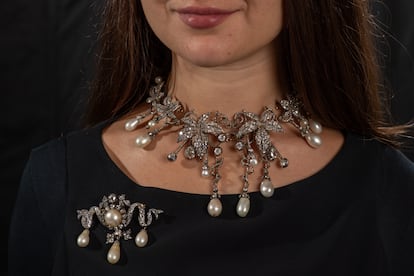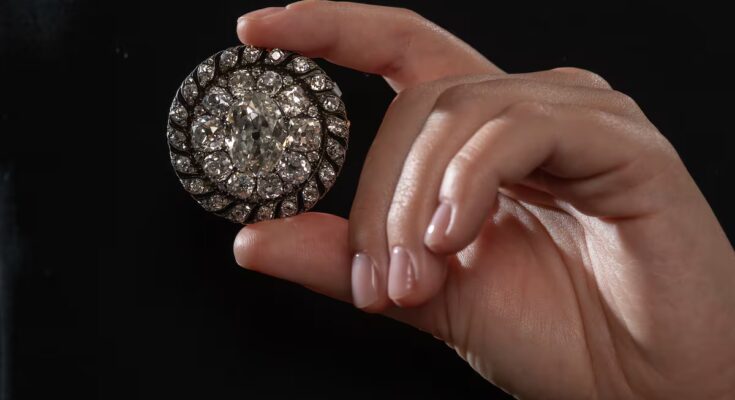Very few have access to these jewels, but we can all dream about them and the story behind them. The famous auction house Sotheby’s is preparing to celebrate one of its most anticipated annual events, the Royal & Noble Jewels auction, on November 12th at the Mandarin Oriental hotel in Geneva. That is, the extraordinary jewels that once belonged to royal and noble families and which, after years in private hands or in royal collections, are looking for new owners.
Despite the offer online It has been active since the end of last October, it will be this Wednesday that the auction will take shape. This year’s star is a diamond brooch that belonged to Napoleon Bonaparte and which he lost in the Battle of Waterloo (1815), for which a starting price is estimated between 150,000 and 250,000 dollars, i.e. between 130,000 and 216,000 euros. Adding to the auction are other spectacular displays of jewelry, such as a unique hair ornament, created around 1840 and auctioned alongside a natural pearl and diamond brooch owned by a European noble family, as well as jewelry from the last Ottoman princess, Fatma Neslisah (died aged 91 in 2012), and a magnificent selection of tiaras.
The beauty of the Napoleon brooch, undoubtedly the flagship of the auction, competes with its historical interest: on the one hand, it is a circular diamond, approximately 45 millimeters in diameter and with a large oval diamond weighing 13.04 carats in the center; The almost one hundred diamonds that surround it, of different shapes and sizes, are arranged in two concentric rows. It was created for Napoleon around 1810, most likely to adorn his bicorn hat on special occasions.
As for its historical value, the brooch was among other personal items the emperor took with him to Waterloo, including medals, weapons, silverware, a hat, and a jewelry box containing dozens of loose diamonds and other jewelry. On 18 June 1815, in his haste to escape from Waterloo, during the battle in which his soldiers had been crushed by the British and Prussian armies, Napoleon had to abandon some of his carriages that were stuck on a muddy road, a few kilometers from the battlefield, including the one containing the brooch, which ended up being offered as a war trophy to the Prussian king Frederick William III on 21 June 1815, just three days after the war. It belonged to the German Hohenzollern dynasty for centuries, before ending up in another private collection where it has remained in recent years. It will now be auctioned for the first time at the next Sotheby’s event, together with another Napoleon jewel, an unmounted green beryl of 132.66 carats – it has a starting price of between 34,000 and 51,000 euros – which Emperor Napoleon I wore at his coronation in 1804 and which also belonged to the Hohenzollerns.
Another of the most anticipated offers is that for the spectacular ring with diamonds and pink diamonds of over 13 carats belonging to the collection of Princess Fatma Neslisah (1921-2012), a jewel also offered for the first time at auction and which testifies to the decline of one of the most historically relevant royal families, the Ottoman one. Its owner was the last to have his birth registered in the palace register of members of his dynasty, before the fall of the once powerful Ottoman Empire. She was thus the last person to officially receive the title of “sultan” or princess of imperial blood and embodied the end of an era of excessive opulence, both in her native Turkey and in Egypt, where she married Muhammad Abdel Moneim (1899-1979), heir of the last ruling house of the Arab country which fell during the revolts.

Among the other precious jewels that make up Sotheby’s offering, the set consisting of a hair accessory and brooch also stands out, which is on sale for a price between 365,000 euros and 537,000 euros and presents itself as an extraordinary example of Romantic jewellery, the ornament being exceptionally rare, perhaps the last known example of a jeweled hair ornament, designed to frame the face. According to family tradition, the important collection of natural pearls that hangs from the jewel and its brooch belonged to Kunigunde of Saxony, Marchioness of Montoro (1774-1820) and cousin of King Louis XVI.
In 2024, Sotheby’s Royal & Noble Jewels auction offered for sale a rare and historic 300-carat 18th-century diamond necklace that had belonged to the Marquesses of Anglesey – with possible connections to Queen Marie Antoinette – one of the rarest Georgian jewels in private hands, fetching $4.8 million at auction.



